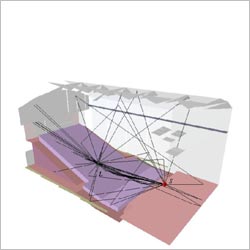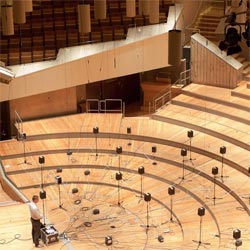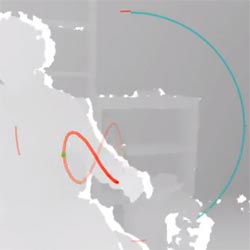- Details
- Published: 07 March 2013
We submitted two papers to ICASSP and both of them were accepted. The first one discusses the differences between different FDTD implementations [1]. The main emphasis is on comparison between one-variable and two-variable schemes to solve the wave equation. The second paper shows an analytic formula that is needed in hybrid acoustic models that join simulation results provided by FDTD and acoustic radiance transfer simulations [2].
References
[1] J Botts and L Savioja. Integrating Finite Difference Schemes for Scalar and Vector Wave Equations. In IEEE Int. Conf. Acoust., Speech, Signal Processing. 2013. BibTeX / Info
@inproceedings{Botts_ICASSP_2013,
address = "Vancouver, BC, Canada",
author = "Botts, J. and Savioja, L.",
booktitle = "IEEE Int. Conf. Acoust., Speech, Signal Processing",
title = "Integrating Finite Difference Schemes for Scalar and Vector Wave Equations",
year = 2013,
abstract = "Room acoustic simulation is the process of generating approximate solutions to either the linearized Euler equations or the scalar wave equation. As for the continuous equations, the discrete approximations of both are equivalent. The vector formulation is less efficient, but it can inform several unexploited features of the scalar formulation. This paper first demonstrates the equivalence of the two schemes and explores how the vector formulation may be integrated into the more efficient scalar formulation to produce local velocity estimates and velocity sources on the pressure grid."
}
[2] S Siltanen, A Southern and L Savioja. Finite-Difference Time Domain Method Source Calibration for Hybrid Acoustics Modeling. In IEEE Int. Conf. Acoust., Speech, Signal Processing. 2013. BibTeX / Info
@inproceedings{Siltanen_ICASSP_2013,
address = "Vancouver, BC, Canada",
author = "Siltanen, S. and Southern, A. and Savioja, L.",
booktitle = "IEEE Int. Conf. Acoust., Speech, Signal Processing",
title = "Finite-Difference Time Domain Method Source Calibration for Hybrid Acoustics Modeling",
year = 2013,
abstract = "Finite-difference time domain methods are commonly used for acoustics modeling of enclosed geometries. For large spaces and high frequencies, the computational requirements become prohibitive in practical use. Thus, geometric acoustics algorithms are used in those cases. The results of these two classes of algorithm can be combined to model the full acoustic response. To allow direct mixing of the results, the source strengths should be calibrated. This paper derives calibration factors for various finite-difference time domain methods. It is shown that the modelled acoustics responses can then be easily combined to synthesise wide-band hybrid responses."
}









